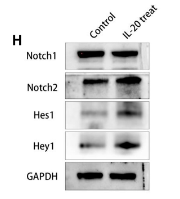HEY1 Antibody - #DF12076
| Product: | HEY1 Antibody |
| Catalog: | DF12076 |
| Description: | Rabbit polyclonal antibody to HEY1 |
| Application: | WB IHC IF/ICC |
| Cited expt.: | WB |
| Reactivity: | Human, Mouse, Rat |
| Prediction: | Pig, Bovine, Horse, Sheep, Rabbit, Dog, Chicken |
| Mol.Wt.: | 32-34 kDa; 33kD(Calculated). |
| Uniprot: | Q9Y5J3 |
| RRID: | AB_2844881 |
Related Downloads
Protocols
Product Info
*The optimal dilutions should be determined by the end user.
*Tips:
WB: For western blot detection of denatured protein samples. IHC: For immunohistochemical detection of paraffin sections (IHC-p) or frozen sections (IHC-f) of tissue samples. IF/ICC: For immunofluorescence detection of cell samples. ELISA(peptide): For ELISA detection of antigenic peptide.
Cite Format: Affinity Biosciences Cat# DF12076, RRID:AB_2844881.
Fold/Unfold
Basic helix loop helix protein OAF1; bHLHb31; Cardiovascular helix loop-helix factor 2; Cardiovascular helix-loop-helix factor 2; CHF-2; CHF2; Class B basic helix-loop-helix protein 31; Hairy and enhancer of split related protein 1; Hairy and enhancer of split-related protein 1; Hairy enhancer-of-split related with YRPW motif protein 1; Hairy related transcription factor 1; Hairy-related transcription factor 1; Hairy/enhancer of split related with YRPW motif 1; Hairy/enhancer-of-split related with YRPW motif protein 1; HERP2; HES related repressor protein 1; HES-related repressor protein 1; HES-related repressor protein 2; HESR-1; HESR1; HEY 1; hey1; HEY1_HUMAN; hHRT1; HRT-1; HRT1; OAF1;
Immunogens
A synthesized peptide derived from human HEY1, corresponding to a region within the internal amino acids.
Expressed in the somitic mesoderm, the central nervous system, the kidney, the heart, nasal epithelium, and limbs.
- Q9Y5J3 HEY1_HUMAN:
- Protein BLAST With
- NCBI/
- ExPASy/
- Uniprot
MKRAHPEYSSSDSELDETIEVEKESADENGNLSSALGSMSPTTSSQILARKRRRGIIEKRRRDRINNSLSELRRLVPSAFEKQGSAKLEKAEILQMTVDHLKMLHTAGGKGYFDAHALAMDYRSLGFRECLAEVARYLSIIEGLDASDPLRVRLVSHLNNYASQREAASGAHAGLGHIPWGTVFGHHPHIAHPLLLPQNGHGNAGTTASPTEPHHQGRLGSAHPEAPALRAPPSGSLGPVLPVVTSASKLSPPLLSSVASLSAFPFSFGSFHLLSPNALSPSAPTQAANLGKPYRPWGTEIGAF
Predictions
Score>80(red) has high confidence and is suggested to be used for WB detection. *The prediction model is mainly based on the alignment of immunogen sequences, the results are for reference only, not as the basis of quality assurance.
High(score>80) Medium(80>score>50) Low(score<50) No confidence
Research Backgrounds
Transcriptional repressor which binds preferentially to the canonical E box sequence 5'-CACGTG-3'. Downstream effector of Notch signaling required for cardiovascular development. Specifically required for the Notch-induced endocardial epithelial to mesenchymal transition, which is itself criticial for cardiac valve and septum development. May be required in conjunction with HEY2 to specify arterial cell fate or identity. Promotes maintenance of neuronal precursor cells and glial versus neuronal fate specification. Represses transcription by the cardiac transcriptional activators GATA4 and GATA6 and by the neuronal bHLH factors ASCL1/MASH1 and NEUROD4/MATH3. Involved in the regulation of liver cancer cells self-renewal.
Nucleus.
Expressed in the somitic mesoderm, the central nervous system, the kidney, the heart, nasal epithelium, and limbs.
Belongs to the HEY family.
Research Fields
· Human Diseases > Infectious diseases: Viral > Human papillomavirus infection.
· Human Diseases > Cancers: Overview > Pathways in cancer. (View pathway)
· Human Diseases > Cancers: Specific types > Breast cancer. (View pathway)
References
Application: WB Species: Human Sample:
Application: WB Species: rat Sample: MSCs
Restrictive clause
Affinity Biosciences tests all products strictly. Citations are provided as a resource for additional applications that have not been validated by Affinity Biosciences. Please choose the appropriate format for each application and consult Materials and Methods sections for additional details about the use of any product in these publications.
For Research Use Only.
Not for use in diagnostic or therapeutic procedures. Not for resale. Not for distribution without written consent. Affinity Biosciences will not be held responsible for patent infringement or other violations that may occur with the use of our products. Affinity Biosciences, Affinity Biosciences Logo and all other trademarks are the property of Affinity Biosciences LTD.





